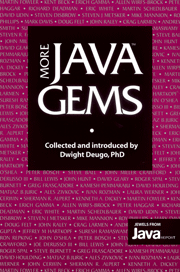Book contents
- Frontmatter
- Contents
- INTRODUCTION
- GETTING STARTED WITH JAVA
- MIGRATING TO JAVA
- TECHNIQUES 101
- MODELING AND PATTERNS
- JAVA IN A DISTRIBUTED WORLD
- THREADS
- USER INTERFACES
- SECURITY
- USING THE JAVASOFT SECURITY PACKAGE
- USING THE JAVA CRYPTOGRAPHIC EXTENSIONS
- JAVA APPLICATION SERVER SECURITY USING CAPABILITIES
- TESTING
- PERFORMANCE
- REALITY CHECK
- INDEX
USING THE JAVASOFT SECURITY PACKAGE
Published online by Cambridge University Press: 06 July 2010
- Frontmatter
- Contents
- INTRODUCTION
- GETTING STARTED WITH JAVA
- MIGRATING TO JAVA
- TECHNIQUES 101
- MODELING AND PATTERNS
- JAVA IN A DISTRIBUTED WORLD
- THREADS
- USER INTERFACES
- SECURITY
- USING THE JAVASOFT SECURITY PACKAGE
- USING THE JAVA CRYPTOGRAPHIC EXTENSIONS
- JAVA APPLICATION SERVER SECURITY USING CAPABILITIES
- TESTING
- PERFORMANCE
- REALITY CHECK
- INDEX
Summary
Last month, Tim Matthews described how JavaSoft is developing a Java Cryptography Architecture (JCA) and extensions (Java Cryptography Extensions, or JCE). He described their contents and structure in the java.security package, and outlined their uses. This month I will present some actual code using the base functionality in the JCA, and next month will program using the JCE and use multiple Providers.
After reading this article, you will, I trust, be able to write a program in Java (an application or applet) that can sign or verify data using DSA with the security package. Beyond the specific DSA example presented here, though, I hope you will understand the JCA model enough to be able to quickly write code for any operation in the package.
Before beginning, however, it is important to note that the java.security package is not part of the JDK 1.0.2, only JDK 1.1 and above. Furthermore, there are significant differences between the security packages in JDK 1.1 and 1.2. This article (and next month's) describes features in 1.2. If you have not yet left 1.0.2 behind, now would be a good time to do so. After all, with 1.2, you are not only getting the security package, you are also getting improved cloning, serialization and many other features.
Now let's look at what a Java program needs to do to use the JCA. Most everything in cryptography begins with the random number generator.
- Type
- Chapter
- Information
- More Java Gems , pp. 295 - 304Publisher: Cambridge University PressPrint publication year: 2000



